2014-11-04By Robbin Laird and Ed Timperlake
We started our visit to The Naval Strike and Air Warfare Center at Fallon Naval Air Station with the outgoing and incoming commanding officers of Plans, Programs and Tactics, or STRIKE (N5) in the Center.
Plans, Programs and Tactics, or STRIKE (N5) is involved in tactics development and assessment for tactical aircraft and SH-60 helicopters, program management and participation, mission planning, and inter/intra service liaison.
They are also the primary trainers for visiting air wings during their “Air Wing det. Fallon” phase of training, prior to deployment.
CAPT (S) Kevin “Proton” McLaughlin: Outgoing STRIKE CO
Our introduction to The Naval Strike and Air Warfare Center was provided by CAPT (S) Kevin “Proton” McLaughlin, outgoing STRIKE CO, previous TOPGUN CO, and Instructor.
He highlighted a number core dynamics involved in the Center as well as discussing a number of key “work aheads” for Naval Aviation.
Clearly, training must focus on fighting with the force you have, but this force evolves over time and one needs to be prepared to incorporate joint capabilities and new capabilities coming the USN and USMC as well.
“Proton” discussed some of those aspects as well.
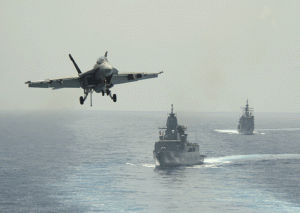
For an outsider, the presence of TOPGUN would suggest the fundamental meaning of Fallon; but this would be clearly incorrect.
As “Proton” explained:
We have a number of core training programs for graduate level proficiency of the primary platforms, such as TOPGUN, for example, with regard to fighters.
But that is for training at the individual level.
The next round of training is for what we call ARP or Advanced Readiness Phase, which is primarily focused at the squadron level.
While the Fallon Ranges are used for ARP’s, the primary instructor cadre comes from the weapons schools located at the fleet concentration centers. Again, using the F-18 example, the weapons schools at Naval Air Station Oceana and at Naval Air Station Lemoore are primarily responsible for ARP training.
The final strata are at the integrated level, which is what we do here at STRIKE. This involves not only all the squadrons in a given air wing, but external naval and joint assets as well.
Question: There is a close interactive process of training between the weapons schools and the wings?
Captain McLaughlin:
There is.
For the F-18 side of the house, TOPGUN is at the top of the training pyramid and the weapons schools basically work for TOPGUN.
TOPGUN develops the tactics, techniques and standardization procedures for the strike fighter aviation and then those TTP’s are pushed to the fleet via the respective weapons schools in Oceana and Lemoore.”
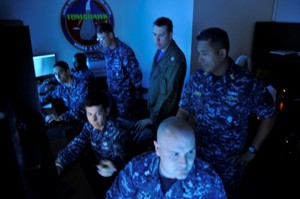
Question: With regard to the strike integration phase, you both provide the training for integration but are in regular dialogue with the deployed carriers to both support them and to learn from their deployment experiences?
Captain McLaughlin:
That is correct.
We support the Combatant Commanders as well as prepare strike integration ashore so to speak.
For example, we have had daily contact with the USS BUSH via email, phone calls and VTCs.
This is an aspect of connectivity, which folds nicely into reshaping the impact and meaning of the training function.
Question: In other words, at Fallon you are operating in a highly interactive combat learning process rather than doing stove-piped training?
Captain McLaughlin:
That is correct.
During the month they’re here, the STRIKE team rolls up their sleeves, and we are with them 24/7 shaping and evaluating the integrated training process with them.
It’s kind of a crawl, walk, run process.
It starts at what we refer to MLT, mission level training, such as a 12 to 16 ship integrated strike against a low-level threats in both the air-to-air and surface-to-air regimes.
The threat capabilities gradually ratchet up and eventually leads to the advanced training phase, which is an A2AD 24-30 plane strike in GPS denied environments, Link-16 denied environments, et cetera, whatever that A2AD for that specific mission set is.
And in that phase we are also working with the USAF, and other non-organic assets because, in the real world, we would be working together against that sort of threat.
Question: Training to A2AD is a major challenge given range limitations and the need to tap a variety of non-carrier resources in conducting that fight.
How are you training to that environment?
Captain McLaughlin:
The current Fallon ranges – although large – are too small to train against an advanced threat, which can shoot longer than the ranges.
We need to train to a 21st Century Plus type of threat with very long-range missiles in the mix.
It is not about succeeding; it is about how are we going to do this with highest probability of success.
We are rolling in Live Virtual Constructive training to provide the extenders for our operators to work in that threat environment and to reach out to other assets – Navy and joint – which can allow us to fight in an expanded battlespace.
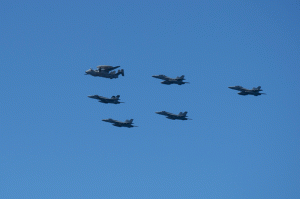
Question: And this approach allows you to fold in over time new blue force assets as well, for example with the Navy the F-35C or the UCAS?
Captain McLaughlin:
It does but F-35C will be much easier to integrate than UCAS as we have a very defined capability set with the JSF but are still unclear about UCAS.
Correspondingly, we have been preparing for the introduction of the F-35C for some time, and have many involved in preparing for its introduction into the fleet.
Question: Certainly, the fight against ISIL has reminded the nation once again of the flexibility of the sea base and how that flexibility really compliments other air power capabilities, which can be brought to the fight?
What is your take on the role of the sea-base in the expanded battlespace?
Captain McLaughlin:
A key advantage of the carrier and sea-basing more generally is the ability to move to the fight with logistics support onboard.
We do not need long lead times and delicate diplomatic negotiations to move to the fight; we just sail to the fight, and given forward presence, we are probably not too far away in any case.
Moreover, as we add new capabilities like the F-35, and enhance our ability to leverage joint and coalition assets we are going to be more effective in the expanded battlespace with the sea base a central element, if not the central C2 capability for the joint or coalition force.
CDR James “Cruiser” Christie: Incoming STRIKE CO
We then had an opportunity to continue the conversation about the strike integration process and challenges with “Proton’s” successor, CDR James “Cruiser” Christie, incoming STRIKE CO, and previous TOPGUN CO
Question: How do you view the function of the STRIKE Command, which you are about to lead?
CDR Christie:
The Naval Strike and Air Warfare Center really is an umbrella organization that brings together several schools of excellence with regard to core combat capabilities, TOPGUN for fighters, CAEWWS (Carrier Airborne Early Warning Weapons School), HAVOC (Airborne Electronics Attack Weapons School), JCAS (Joint Close Air Support), and the rotary wing training school or RWWS.
At STRIKE we focus on the integration of these various core competencies into an integrated strike force, which will operate off of the carrier.
Question: Clearly, a key aspect of integration is that it is not fixed but is reworked as new assets come into the fleet.
As we understand it, the latest assets might go to the fleet and then after initial deployments come to Fallon for the learning curve into the integration effort?
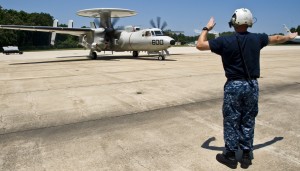
CDR Christie:
That certainly can happen, but isn’t ideal.
For example, our first air wing with E2-D, the new Hawkeye, is coming here in a couple of weeks.
We have been working with them over the past year in various parts of their workup because the rollout of the E-2D platform has been accelerated.
We’ve sent TOPGUN instructors, and CAEWWS instructors, and STRIKE instructors down to work with CVW-1 and VAW-125 supportive of that effort.
Typically, the Fleet won’t get a platform or capability until it has been thoroughly tested and validated by our test pilot community.
At Fallon, we focus the bulk of our work on Tactics, Training and Procedures (TTPs) for the fleet.
We’re chartered to create the tactics of the future, and to be able to do that we need to know where revolutionary advances are happening, and to understand those new capabilities thoroughly.
So with regard to the new Hawkeye, we sent staff members with either an E-2D or fighter integration background to meet with the squadron and air wing team during their workups to help them work through optimal tactical implementation of their new assets.
Question: Another key aspect is building an evolving understanding of the threat from more advanced adversaries as well.
How do you do that?
CDR Christie:
We have threat specific subject matter experts who maintain close connections with various intelligence agencies, and with our allies, to better understand the evolving threat environment.
Our subject matter experts convey that knowledge to tactics instructor students in class.
And clearly, you want to train to the high-end threat, the most capable potential threat out there — their hardware, their assessed pilot capabilities, their integrated air defense networks.
You train against that as best you can, or something generically mimicking a high-end threat.
Combat is a complex environment that does not suffer fools.
Question: The upgraded Hawkeye is a new asset and presumably you are preparing for the F-35 becoming an integral part of the strike package.
How are you preparing for the introduction of the F-35 into your strike integration thinking?
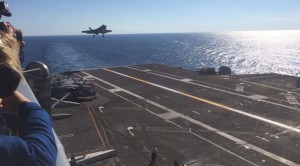
CDR Christie:
We are preparing for sure.
TOPGUN has a team of instructors working with MAWTS and Nellis to shape common TTPs.
And we have been doing that for three years.
We have already written the initial employment documents with how to integrate the F-35 into the fight.
And to be clear, the Navy, Marine Corps and Air Force are all working together on this.
We’re not simply waiting for the plane to come to Fallon, and of course, we have our Fleet Replacement Squadron (FRS) training and instructing at Eglin AFB.
We maintain a close working relationship with Nellis.
We have an Air Force exchange pilot on staff at TOPGUN and STRIKE, and a former TOPGUN instructor pilot is assigned to Nellis.
Most recently, the Air Force exchange officer at TOPGUN was an F-16 pilot.
We see this as an important trade space for intellectual ideas on how to succeed in 21st century air combat.
In order to conduct a truly joint operation with symbiosis, it is important for both weapons schools to send their best tacticians and aviators to each other’s facilities.
This is how you realize fully integrated capabilities operating in the joint realm. And this exchange has been going on for more than a decade.
Question: What you are describing is shaping a cadre of tacticians and operators who can actually think about convergent operations?
CDR Christie:
That is a good way to put it.
To operate jointly, you cannot do it from a book or simply be handed directives.
You need to understand how the other service operates, how it is different and where commonalities can actually yield capabilities.
Biography of CAPT (S) Kevin “Proton” McLaughlin
A native of Newport Beach, CA. CDR Kevin McLaughlin enlisted in the Navy in 1989 and was named Navy League Outstanding Recruit for his graduating cadre. Following ET ‘A’ School and Navy Nuclear Power School in Orlando, FL., the then ET3 McLaughlin transferred to Nuclear Power Training Unit (NPTU) in Idaho Falls, Idaho. Upon completion of prototype, he was en route to the USS Helena (SSN 725) when he was accepted into the Naval Aviation Cadet program.
CDR McLaughlin graduated from Aviation Officer Candidate School as the class Distinguished Naval Graduate and proceeded to Primary flight training in Corpus Christi, TX. Upon completion of primary flight training he received a jet slot and subsequent training in Kingsville, TX. Following Intermediate and advanced jet training, and newly commissioned, CDR McLaughlin received orders to the F/A-18 Fleet Replacement Squadron (FRS) at MCAS El Toro, CA. During his FRS tour he was awarded the 1993 David McCampbell Award as the top Air Combat Maneuvering student pilot in the Navy. Following completion of the FRS, CDR McLaughlin was assigned to NAS Lemoore, CA. and VFA-146.
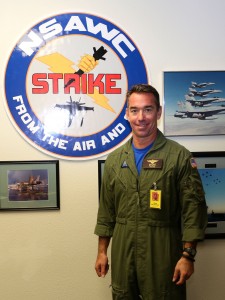
CDR McLaughlin served in VFA-146 from December 1994 to December 1997 and had various duties including Line Division Officer, Quality Assurance Officer, Schedules Officer, Communications Officer, Landing Signals Officer, and Air-to- Air Weapons Training Officer. During his tenure he made two deployments on board the USS NIMITZ (CVN 68) in support of Operation SOUTHERN WATCH (OSW) in the Arabian Gulf. He was named as the Charles H. Bryant Leadership Award winner for 1997.
Upon completion of CDR McLaughlin’s tour in VFA-146, he was assigned to NAS Fallon, NV. as an instructor at Naval Strike and Air Warfare Center and Navy Fighter Weapons School (TOPGUN) where he taught graduate level tactics to both F/A-18 and F-14 combat aircrew. While assigned, CDR McLaughlin served as the Maintenance Officer and the Fleet Training Officer.
Completing his TOPGUN tour in February 2001, CDR McLaughlin transferred back to NAS Lemoore for duty as the Strike Fighter Tactics Instructor and Training Officer aboard VFA-151. During this tour, he made another six-month deployment in support of OSW onboard the USS CONSTELLATION (CV 64) and was named the VFA-151 Junior Officer of the year for 2001. In 2002, CDR McLaughlin was selected as a Washington DC Intern Fellow where he received a Masters in Organizational Management from George Washington University while interning on both the Navy and Joint Staffs.
Upon completion of his tour in Washington, CDR McLaughlin returned to Lemoore for his Department Head tour assigned to VFA-94. During his two-year tour he made another six-month deployment, this time in support of Operation IRAQI FREEDOM aboard USS NIMITZ (CVN 68) and served as the Safety, Maintenance, and Operations Officer.
In November of 2006 he was assigned as the Organizational Policy Officer to the J-5 Plans and Policy directorate of the United States Northern Command in Colorado Springs. He was selected for Operational Command in 2008 and completed training in the FA-18E Super Hornet, for eventual assumption of duties as Executive Officer of VFA-14 in 2010. CDR McLaughlin then assumed the duties as Commanding Officer of VFA-14 in July 2011 and led the squadron through a combat deployment in support of Operations NEW DAWN and ENDURING FREEDOM aboard the USS JOHN C STENNIS (CVN 74). While in Command, VFA-14 was selected as the 2012 RADM Wade McClusky recipient for outstanding Attack Squadron in the US Navy. Upon completion of his Command tour, CDR McLaughlin was assigned to the Naval Strike and Air Warfare Center to assume duties first as TOPGUN and then STRIKE Department Head.
He has over 3500 hours and 850 carrier landings aboard eight different carriers. Personal awards include the Defense Meritorious Service Medal, Meritorious Service Medal, Strike-Flight Air Medal (3), Navy Commendation Medal (3), Joint Staff Achievement Medal, Navy Achievement Medal (4), Good Conduct Medal, and various other unit awards.
Biography of Commander James D. “Cruiser” Christie
Commander James Christie graduated from the U.S. Naval Academy in 1994 with a degree in Mechanical Engineering and then commissioned an Ensign. Winged a Naval Aviator in Kingsville, TX in 1997, he received orders to the “Sharpshooters” of VMFAT-101 to commence training in the FA-18 Hornet. He subsequently reported to the VFA-137 “Kestrels” in May 1998 at NAS Lemoore and deployed twice in support of Operation SOUTHERN WATCH aboard USS Constellation (CV 64).
In 2001, Commander Christie reported to the VFA-122 Flying Eagles at NAS Lemoore, CA as an FA-18E/F Super Hornet flight instructor and Landing Signals Officer. After one year at VFA-122, he attended Navy Fighter Weapons School (TOPGUN) with follow on orders to Strike Fighter Weapons School Pacific as a Strike Fighter Tactics Instructor (SFTI) specialized in FA-18 Combat Systems.
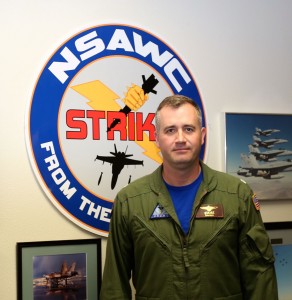
Commander Christie was next assigned to the VFA-2 “Bounty Hunters” in 2004 as the Pilot Training Officer and completed a deployment in support of Operation Unified Assistance to provide tsunami relief for Indonesia.
In 2005 he joined the VFA-22 “Redcocks” as a department head and completed a combat deployment aboard USS Ronald Reagan (CVN 76) in support of Operations IRAQI FREEDOM and Pacific Command’s inaugural Valiant Shield Exercise, shortly followed by a surge deployment in support of 7th Fleet operations.
In January 2009, Commander Christie graduated from the Naval War College in Newport, RI with a Masters of Arts in National Security and Strategic Studies. He then completed an Individual Augmentee assignment to the Force Strategic Engagement Cell, Multi-National Force Iraq (MNF-I) in Baghdad as the lead strategist for Shia insurgent reconciliation.
In January 2011, Commander Christie reported to the Black Knights of VFA-154 as Executive Officer. He immediately deployed for CVW-14’s sunset eight-month deployment in support of Operations TOMODACHI, NEW DAWN and ENDURING FREEDOM aboard USS Ronald Reagan (CVN 76).
Upon return and decommissioning of CVW-14, the Black Knights transferred to CVW-11. Commander Christie took command of VFA-154 in May 2012 to lead the Black Knights through work-ups and another deployment in support of Operation ENDURING FREEDOM aboard the USS Nimitz (CVN 68).
In September 2013, Commander Christie reported to Naval Strike and Air Warfare Center (NSAWC) as TOPGUN’s Commanding Officer. In October 2014, he transferred from TOPGUN to STRIKE within NSAWC. He has logged 3000 flight hours in the F-18A-F and has accumulated more than 800 arrested landings.
His awards include the Meritorious Service Medal (2 awards), Strike Flight Air Medals (3 awards), Navy Commendation Medals (2 awards), Navy Achievement Medals (2 awards) and numerous other campaign and unit awards.
Earlier pieces from our Fallon visit in October 2014:
https://sldinfo.com/the-rotorcraft-the-carrier-and-training-for-strike-integration/
https://sldinfo.com/visiting-fallon-naval-air-station/
The photos in the slideshow above were shot during our visit to Fallon.

